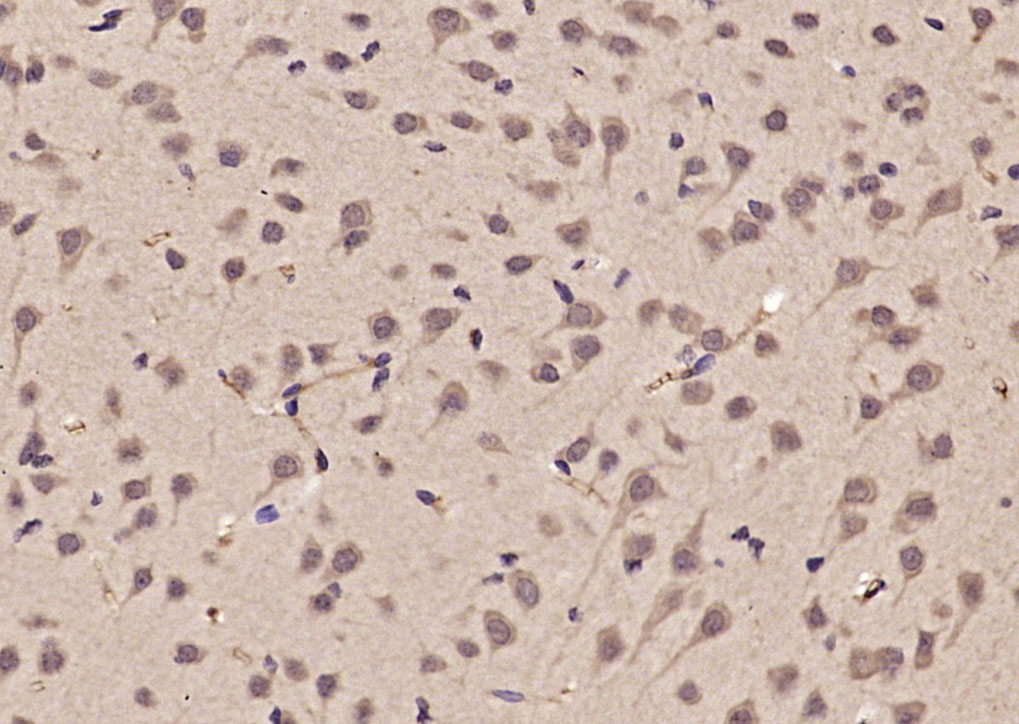
Rabbit Anti-FIG4 antibody
5-bisphosphate 5-phosphatase; Fig4; FIG4_HUMAN; KIAA0274; ALS11; Phosphatidylinositol 3; hSac3; Phosphatidylinositol 3,5 bisphosphate 5 phosphatase; Polyphosphoinositide phosphatase; SAC domain containing protein 3; SAC domain-containing protein 3; SAC3.
View History [Clear]
Details
Product Name FIG4 Chinese Name 肌萎缩侧索硬化症相关蛋白FIG4抗体 Alias 5-bisphosphate 5-phosphatase; Fig4; FIG4_HUMAN; KIAA0274; ALS11; Phosphatidylinositol 3; hSac3; Phosphatidylinositol 3,5 bisphosphate 5 phosphatase; Polyphosphoinositide phosphatase; SAC domain containing protein 3; SAC domain-containing protein 3; SAC3. Research Area Cell biology Neurobiology Signal transduction Immunogen Species Rabbit Clonality Polyclonal React Species Rat, (predicted: Human, Mouse, Chicken, Dog, Pig, Sheep, Monkey, ) Applications WB=1:500-2000 ELISA=1:5000-10000 IHC-P=1:100-500 IHC-F=1:100-500 ICC=1:100-500 IF=1:100-500 (Paraffin sections need antigen repair)
not yet tested in other applications.
optimal dilutions/concentrations should be determined by the end user.Theoretical molecular weight 104kDa Cellular localization The cell membrane Form Liquid Concentration 1mg/ml immunogen KLH conjugated synthetic peptide derived from human FIG4: 1-100/907 Lsotype IgG Purification affinity purified by Protein A Buffer Solution 0.01M TBS(pH7.4) with 1% BSA, 0.03% Proclin300 and 50% Glycerol. Storage Shipped at 4℃. Store at -20 °C for one year. Avoid repeated freeze/thaw cycles. Attention This product as supplied is intended for research use only, not for use in human, therapeutic or diagnostic applications. PubMed PubMed Product Detail The protein encoded by this gene belongs to the SAC domain-containing protein gene family. The SAC domain, approximately 400 amino acids in length and consisting of seven conserved motifs, has been shown to possess phosphoinositide phosphatase activity. The yeast homolog, Sac1p, is involved in the regulation of various phosphoinositides, and affects diverse cellular functions such as actin cytoskeleton organization, Golgi function, and maintenance of vacuole morphology. Membrane-bound phosphoinositides function as signaling molecules and play a key role in vesicle trafficking in eukaryotic cells. Mutations in this gene have been associated with Charcot-Marie-Tooth disease, type 4J. [provided by RefSeq, Jul 2008]
Function:
The PI(3,5)P2 regulatory complex regulates both the synthesis and turnover of phosphatidylinositol-3,5-bisphosphate (PtdIns(3,5)P2). In vitro, hydrolyzes all three D5-phosphorylated polyphosphoinositide substrates in the order PtdIns(4,5)P2 > PtdIns(3,5)P2 > PtdIns(3,4,5)P3. Plays a role in the biogenesis of endosome carrier vesicles (ECV) / multivesicular bodies (MVB) transport intermediates from early endosomes.
Subcellular Location:
Endosome membrane. Localization requires VAC14 and PIKFYVE.
DISEASE:
Defects in FIG4 are the cause of Charcot-Marie-Tooth disease type 4J (CMT4J) [MIM:611228]. CMT4J is a recessive demyelinating, severe form of Charcot-Marie-Tooth disease, the most common inherited disorder of the peripheral nervous system. Charcot-Marie-Tooth disease is classified in two main groups on the basis of electrophysiologic properties and histopathology: primary peripheral demyelinating neuropathies characterized by severely reduced motor nerve conduction velocities (NCVs) (less than 38m/s) and segmental demyelination and remyelination, and primary peripheral axonal neuropathies characterized by normal or mildly reduced NCVs and chronic axonal degeneration and regeneration on nerve biopsy.
Defects in FIG4 are the cause of amyotrophic lateral sclerosis type 11 (ALS11) [MIM:612577]. ALS is a neurodegenerative disorder affecting upper motor neurons in the brain and lower motor neurons in the brain stem and spinal cord, resulting in fatal paralysis. Sensory abnormalities are absent. Death usually occurs within 2 to 5 years. The etiology of amyotrophic lateral sclerosis is likely to be multifactorial, involving both genetic and environmental factors. The disease is inherited in 5-10%.
Similarity:
Contains 1 SAC domain.
SWISS:
Q92562
Gene ID:
9896
Database links:Entrez Gene: 9896 Human
Entrez Gene: 103199 Mouse
Omim: 609390 Human
SwissProt: Q92562 Human
SwissProt: Q91WF7 Mouse
Unigene: 529959 Human
Unigene: 277242 Mouse
Product Picture
Bought notes(bought amounts latest0)
No one bought this product
User Comment(Total0User Comment Num)
- No comment



 +86 571 56623320
+86 571 56623320
 +86 18668110335
+86 18668110335

